S & H Festival Report
LUCERNE FESTIVAL 2002 COMPOSERS IN RESIDENCE, MUSIC THEATRE, SYMPHONY CONCERTS, CHAMBER MUSIC AND DEBUT RECITALS, MASTER CLASSES (2-12 September, PGW)
Three previous reports in 2001 will have left readers in no doubt that the Lucerne Festival (divided into Easter, Summer and Autumn sections) is one of the greatest and most comprehensive in Europe and, probably, anywhere; nor can it be questioned that the KKL Konzertsaal by the lake, next door to the station and the pier, is the ideal venue to enjoy hearing a procession of the world's greatest symphony orchestras in standard repertoire to best advantage. Those concerts are usually sell-outs and early planning is necessary to ensure affordable seats, from all of which the sound is excellent. (To view the hall, inside and out, please click the links above before reading on.)
Such a success story does however carry some risks and although, under Michael Haefliger's artistic direction, the Lucerne Festival has a strong commitment to new music, there is a noticeable compartmentalisation so that most of the innovative presentations take place in other venues around the town. There are parallels with the Salzburg Festival under new direction, which the Financial Times writer (16 September) found disappointingly unexciting, contented patrons "going from their expensive seats to their exclusive expensive restaurants"; probably only a minority of the KKL Konzertsaal's symphony concert audience venture next door to the Lucerne Hall, let alone farther afield, where audiences were sometimes modest.
So, for our second visit to the Lucerne Summer Festival, which ran from 14 August to 15 September, we chose to concentrate more upon chamber music and contemporary music. The featured composers in residence this year were Boulez, whose scores may not be as familiar in Switzerland as in the rest of Europe, and Olga Neuwirth, a rising star from Austria, less familiar to us, here presenting Swiss music lovers and foreign visitors with a welcome opportunity to experience her output in extenso.
COMPOSERS IN RESIDENCE
Pierre Boulez was enjoying an extensive retrospective and we heard two of his works with electronics in the Lucerne Hall, a large studio type auditorium, more austere than the Konzertsaal next door, with flexible seating and platform arrangements, and well suited to experimental music. We entered to find a 'music in the round' set up, with loudspeakers all around the hall, a square stage in the centre and four blocks of seats surrounding it; but this proved illusory.
For Anthemes 2 (1997) 'pour violon et dispositif electronique', the soloist Jeanne-Marie Conquer stood on the platform in a central spot-lit circle, but she remained resolutely immobile, with her back towards us, through the 6 sections of this accessible augmentation of unaccompanied violin music with imaginative electronic efflorescenses growing around the motifs initiated by the soloist. Returning after the interval for Boulez's 45 min 1984 version of Repons (1981, 'work in progress') - still incomplete, intended to grow to 60-70 mins to fill a CD - we found ourselves behind a conventional orchestral arrangement and separated from the musicians of Ensemble Intercontemporain by a line of perspex screens which had been placed in front of our seats! Immediately before us was the tuba, whose bell alone emerged above the parapet. We could see pianos in two corners of the hall, and the cimbalom behind us, reflected in the perspex, but not at all the solo harp, xylophone and vibraphone. In 2002, two decades after its first airings, I was less overwhelmed than the enthusiastic Swiss audience appeared to be by Repons, originally a landmark vision of what it was hoped that electronics and IRCAM might offer for the future of contemporary music. I now find its proliferation of simultaneous decorative lines tend to cancel each other out, with diminishing returns for its complexity. For me, the whole amounted to less than its 1997 companion Anthemes 2 , which required just one live instrumentalist and, indeed, offered less satisfaction than either of two new string quartets by Komarova and Lachenmann reported below. Both of those deserve to enter the repertoire and, being relatively more 'cost effective', are bound to be programmed more often than Repons.
I felt that the Boulez event had been somewhat affected by the Lucerne Festival's inclination towards formality (black ties for symphony concerts!) and that it would have benefited from the informality which Boulez brought to London's BBC concerts in the Round House during his influential incumbency during William Glock’s time. If Repons is revived in the UK again - whether completed or not - it would be worth considering having a reduced number of seats for those who need them and allowing the audience to wander around the auditorium during the performance. But there is a serious danger that if it is ultimately completed, Repons may by then sound even more dated and overcome by newer new music.
Olga Neuwirth (b.1968) received generous exposure, with no expense spared, during our time in Lucerne. We were promised to be kept spellbound by her 'practically inexhaustible imagination in discovering new sounds and forms' (Michael Haefliger). Neuwirth's multimedia work The Long Rain had made a powerful, if bewildering, impression in London, and is now available on col legno's Donaueschinger Musiktage 2000 CDs (WWE 20201).
Although I was greatly taken by her string quartets in the Arditti Quartet's concert (see below), I subsequently found little in Neuwirth's aesthetic that I was able to relate to during a long evening spent with her music from 9 p.m. until after midnight - we did not survive to the end of Remixing Olga Neuwirth, scheduled to last up to another hour, presented by 'DJ Spooky the Subliminal Kid' from the USA, whose cult following was evidenced by many CDs on sale. Our difficulty was less surprising after reading, in the Ricordi catalogue, that her compositions 'are like twisting labyrinths - - all the factors that can give the ear support are absorbed or wiped away by the music' (Stefan Drees). Verily!
Pierre-André Valade directed Collegium Novum Zurich, the composer played the theremin in improvisations with two bass clarinets and guitar, and Thomas Larcher battled with seemingly simplistic piano concertante parts (I fear I did not get the point, and was unable to read the mass of interview and supporting explanatory material in German about Neuwirth's work). I did enjoy Spleen I & II, the former a conversational solo for bass clarinet exploring extended techniques and vocal sounds with humour, reminiscent of Berio's trombone Sequenza, the other not important enough to justify the expense of acquiring a bass flute to play it! Best was a tribute to a famous pop star, Hommage à Klaus Nomis, with the English counter-tenor Andrew Watts whooping his way through So simple and Dido's Lament etc with great good humour.
Olga Neuwirth has an extensive discography and is clearly a force to be reckoned with. Intrepid explorers could consider a Portrait CD which includes Hooloomooloo (included in Collegium Novum Zurich's programme) and Instrumental Islands from Bählamms Fest. (Kairos 0012242 KAI) and her string quartet Akroate Hadal on ORF13, MP95. We must all keep trying!
MUSIC THEATRE (Neuwirth and Vecchi)
We found the Swiss première of Olga Neuwirth's elaborate music theatre entertainment at Lucerne Theatre bewildering. Bählamms Fest, based on Leonora Carrington's Baa Lamb's Holiday, featured headless sheep, a talking dog and assorted human grotesques who interacted unhappily in increasingly macabre goings-on. It starts harmlessly with little sheep tumbling over a screen on stage, but gradually the video game becomes diabolical (as do some of those our children play!). At their Christmas party shepherds shoot lambs out of the sky with electronic joysticks, monstrous events happen under the cover of innocence, an accepted healer is unmasked as a killer and the everyday turns into hell. First given in Vienna 1998, in this revival its sophisticated use of sound projection and computerised visual effects was notably impressive. Not quite an opera, it was sung and acted with conviction but to what overall purpose I remained unsure, lacking German to take in before it began the synopsis in the programme, and not greatly assisted in retrospect by translations made for me afterwards.
I Fagiolini is one of the UK's most versatile and enterprising vocal ensembles. Their director Robert Hollingsworth has now branched out into reviving Venetian madrigal comedies with mime in masks. These entertainments give more than antiquarian pleasure and entranced a full house at Lucerne Theatre. The company consisted of eight singers - three of them also accomplished mime actors - supported by harpsichord and theorbo/cittarone. After a group of madrigals by Andrea Gabrieli we had musical games by Giovanni Croce (1557-1609), sung and enacted with great aplomb, and for the main course, Orazio Vecchi's L'Amfiparnasso (1597), the earliest surviving example of the madrigal comedy genre. Three members of I Fagiolini donned costumes to mime all the characters in stock Commedia del Arte situations and did so with flair and style. Two speakers linked the episodes (in German, translated from the English) with witty updating which brought gales of laughter, as did the antics of the mimers, whilst the madrigalists sung the scenes between the protagonists of the broad comical situations, which would have been familiar to the original audiences, without assigning parts to individual singers. L'Amfiparnasso is not an opera, and all five madrigalists (six when Hollingsworth exchanged his disguises for music stand) share the dialogue collectively; a format which could have considerable potential for contemporary music theatre (and indeed we noticed that the Musikhochschule Luzern will be touring Swiss cities in October with Il Gong Magico, a Mimopera by Thüring Bräm). Vecchi's settings are ingenious and a delight in their own right, and this well conceived show was deservedly a great success in the Lucerne Festival. I expect I Fagiolini will be touring to various early music festivals with L'Amfiparnasso; well worth catching, and afterwards perhaps some wise sponsor would support a DVD of this production, which would benefit from subtitles in language of choice.
Readers are urged to click onto my review of I Fagiolini's collaborative Simonye project in Soweto (one of my earliest for S&H), which resulted in an inspiriting CD (Erato 0630 18837 2); not too late to catch up with it!
SYMPHONY CONCERTS
We attended but three of the 32 designated symphony concerts, the most rewarding being that by Hans Zender with the SWR Sinfonieorchester Baden-Baden und Freiburg. Their programme took full value from the KKL Konzertsaal's unique capacity to clarify textures and allow the quietest music to carry to the furthermost seats. It was framed by Wagner, included an interesting rarity, Max Reger's Four Symphonic Poems Op.128 on pictures by the Swiss painter, Arnold Böcklin, and, from a contrasting aesthetic, Debussy's Trois Nocturnes. This was a super-subtle pianissimo concert, with the orchestra's voice rarely raised, nor was there any fast music until we had heard the five Wesendonck songs (Luana de Vol) and reached the second of Reger's pictures, the Play of the Waves. I was particularly glad to see for the first time Hans Zender, who had been responsible for the historic premieres of Scelsi's major orchestral works shortly before the composer's death and had sent me tapes of those Munich performances. A small man, authoritative but not at all exhibitionistic, he conducts (the orchestra, not the audience!) with economical movements and there was that elusive chamber music feeling which happens when musicians in a large orchestra listen intently to each other. Zender has a vast discography and is also a significant composer; I enjoy immoderately his controversial 'recomposition' of Schubert's Winterreise (BMG 09026 68067-2).
The evening finished with a resplendent account of the Prelude & Liebestod from Tristan and we departed content, and not minded to join the lists between Wagner and Debussy, whose Nocturnes were part of a conscious revolt against both Germanic tradition and Parisian academicism.
The Amsterdam Concertgebouw's account of Mahler 3 under Eliahu Inbal had evidently been neater than at the Proms the previous week (see the review in Seen&Heard by PQ, one of MusicWeb's several Mahler specialists). Inbal had deputised at very short notice for Riccardo Chailly in London and was again at the helm. Despite the miraculous clarity of every strand in this huge and problematic symphony as heard in the KKL, I found myself uninvolved in the bombast of the opening march, disappointed that the central movements were unduly cool, and resistive to the grandiose, prolonged fortissimo peroration of the final adagio, of which its opening had been rare balm.
On our last morning in Lucerne I was able to join Russ Johnson again at the KKL Konsertsaal, for Christoph von Dohnányi rehearsing the Philharmonia Orchestra in Strauss and Brahms. Johnson explained the inexhaustible fascination of supervising the sound palette, each work and each orchestra and conductor combining to set up a multitude of variables, which have to be fed into the computer which controls the set-up of canopy, reverberation chambers and curtains. He also pointed out that Dohnányi's 'flat' platform arrangement was designed to filter the tone of winds and brass through the strings, achieving thereby better balance and blend, advantageous for projecting string tone. All these elements which affect listeners can be added to the KKL's data base, but there are still additional factors which arise and necessitate personal supervision and occasional prompt intervention. This support is provided by Artec, with sometimes as many as five representatives of the firm in attendance. Johnson himself spends a good part of the Summer Festival in Lucerne (he commuted to the USA and back whilst I was there!) and he also keeps a watching brief on the Easter and Autumn Festivals, as well as some other events put on by the hall, outside the Lucerne Festival organisation.
The rehearsals of Till Eulenspiegel and, from Salome, the Dance of the Seven Veils and final scene, gave me an opportunity to enjoy once again the sound of a great British orchestra on top form, responsive to every detail practised with Dohnányi and rousing to tremendous, thrilling climaxes. Inga Nielson sang her love song to Jokaanan's head to appreciative acclamation by conductor, orchestra and scattered listeners, giving full voice in the morning (Dohnányi had the leader check balance out in the auditorium); a special singer to watch out for. Working on Brahms’ Fourth he tidied up a few moments and then the music somehow took over; they continued uninterrupted to the end of the first movement, at which point I had to leave. As one experiences with master class lessons, eavesdropping at the development of an interpretation in rehearsal is sometimes as rewarding as a final concert performance; I was pleased to note that the Lucerne Festival provides opportunities for students to attend rehearsals by the finest orchestras.
András Schiff in control?
The Chamber Orchestra of Europe's concert which we attended in the KKL Konzertsaal was not a symphony concert, though billed as such, nor was it a happy event. It was directed throughout by András Schiff, who sat with his back to the audience and tried to co-ordinate all the disparate items from the keyboard of his beloved dry, percussive Fabrinni/Steinway. He had no more than variable success in combining roles, conducting busily (and distractingly) with rolling body movements whilst playing, and leaping up onto his feet when the music allowed a few moments respite. Best in the concert (though out of place in context) was Janacek's wonderfully radical and quirky Capriccio of 1926, composed for the pianist Otokar Hollmann who had lost his right arm in the first World War. This demonstrated how well chamber music sounds in the large Konzertsaal, though it is admittedly chamber music like none other, with piccolo and tuba at the tonal extremes - but it did leave Schiff's right hand free to conduct throughout, quite a feat! Perhaps he'll go on to tackle the great Ravel & Franz Schmidt works for piano-left-hand and orchestra in this manner?
The chamber-music feeling generated by giving the Schumann concerto that way with quite a large orchestra (underpinned by three double basses) was at a price. The concerto seemed to take less time than the programme book's precisely allotted 29 mins. The COE’s orchestral contribution was forthright but the whole lacked affectionate phrasing and was less than endearing.
This misconceived programme was framed by two Bach orchestral suites (+ the Air on the G String as the inevitable encore). Given by a large, modern instrumental group with piano accompaniment, they made an anachronistic effect, despite paying lip service to informed historical style with double dotting and sparing vibrato. Lest readers think I am being unduly critical, besides being out of step with Schiff's warmly appreciative audience, the Neue Luzerner Zeitung was even more outspoken, condemning András Schiff as a showy egoist who appropriated Bach's music for his own purposes, showed poor taste and judgement in attempting to do everything, and control everything - 'the music the victim' (Klaus Schadeli).
In his talk at Lucerne, Schiff declared himself, as reported, to be an unashamed romantic reactionary who dislikes the harpsichord and has no time for those musicologists and practising musicians whose discoveries have enlivened and broadened the appreciation of early music, but whose attitudes he caricatured as 'Kulturfaschismus'. Although I have no aversion whatsoever to Bach's solo keyboard music on modern piano, Schiff's backlash against the take-over by period specialists gives me no satisfaction, although it clearly delighted the festival audiences at his Lucerne appearances. I have so enjoyed Schiff’s playing over the years, live and on CD (and on C19th. period pianos as well as on his personal Steinway, specially prepared by Fabrinni), that I wonder if the problem is partly that of so many busy soloists, whose schedules leave them little time to reflect and reconsider; the wise recent article. The visionary thing. by Susan Tomes in the Guardian – and the recently published ABRSM Performers’ Guides - leave no doubt that early music experts are far more tolerant and open minded than András Schiff might believe.
Looking Forward: Educational Programme and Master Classes
More rewarding than attending his concert was it to sample András Schiff at the Musikhochschule taking a Bach interpretation master class; these classes are always fascinating to observe, conducted as they are by famous musicians, each in an individual manner. They are an important and integral feature of the Lucerne Festival (even though a majority of the audiences which fill the KKL at premium prices may not get beyond the symphony concerts) and they are organised on a generous scale, with selected students each allotted several hours individual tuition over five or six days, culminating with a group rehearsal and concert to finish. This year's ambitious teaching programme covered the whole field of conducting and interpretation, singing & opera, instrumental solo & chamber music interpretation, with input from notabilities featured in the concert programmes themselves, such as Pierre Boulez, Matthias Goerne, Pierre-Laurent Aimard, members of the Hagen Quartet and musicians of the Chicago Symphony Orchestra. The scope and intensity of this commitment to upcoming professional musicians underpins a great summer festival which lasts from mid-August to mid-September and is better known for its procession of the world's greatest symphony orchestras and the unique KKL Konzertsaal which allows them to be heard (and to hear themselves) as nowhere else.
András Schiff was working at interpretation before an audience of observers with 10 soloists or duos; string players amongst pianists, who were in the majority. I watched him take two well equipped pianists, who were able to respond quickly to his instructions, through the Italian Concerto (Chiara Sarchini) and the D major Partita, "it must be joyous, orchestral" (Andrés Carciente). This was not an occasion for discussing interpretative choices; Schiff comes with fixed views and taught the students to copy his way, by descriptive analogy as occurred on the instant, and often by demonstration at a second piano, sometimes playing along and conducting to maintain the pulse. He taught in several languages, ignoring the audience; it was easy to follow what he was wanting and I find that the best way. A concert in the Marianischer Saal completed the course, with Andrés Carciente repeating his Bach Partita, and several participants playing Beethoven, most notably Oezgür Aydin from Turkey. He was clearly the best performer, a finished interpretative artist, having too an advantage in that the D minor Sonata Op. 31 No.2 is an inexhaustible masterpiece, towering above the 32 Variations in C minor and the early cello sonata Op 5 No.2, the latter a daunting test of the pianist's stamina, particularly when all repeats are taken as they were throughout the programme, nearly two hours without interval.
Veronika Hagen's Master Class and Schlusskonzert. It was a privilege to be welcomed as the sole observer (it being 9 a.m.) at the last of five lessons given by the violist of the Hagen Quartet to a gifted violist from Berlin, Katja Plagens, in the ornate studio in the Conservatorium or Musikhochschule, a magnificent building high on a hill overlooking Lake Lucerne
.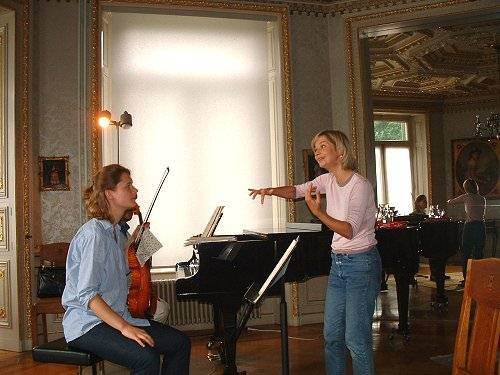
Having confirmed that I spoke no German, Veronika Hagen & her pupil switched gladly to English for my benefit! This was a pupil-centred lesson on the subtleties of interpreting Schumann's Marchenbilder so as to bring fully to life their fantasy and feeling, for listeners "who need us musicians to get away from being locked all day in front of their computers"! She advocated that, after mastery of the score itself in fullest detail, imaginary stories could help the player to structure performance of a piece and bring it fully to life. Both Veronika Hagen and Katja Plagens used this device spontaneously to evident effect and shared pleasure. At the end of a week spent together rapport was excellent and nerves banished; each participant also listening to lessons given to the other four selected violists (advanced music students and viola players already working professionally). The atmosphere was warm, always encouraging, and indeed loving in response to passages which 'worked' and moved Ms Hagen - and me too!
They tackled issues of phrasing and there was a lot of attention to the essential basis of bodily posture, standing and sitting - firm support on two feet pointed forward exactly in parallel, yet not rigidly like a soldier; feel free to turn the body as a whole, as a flower might bend in the breeze. To prevent neck tension developing eyes too should be directed straight forward at the score; an amusing illustration of that problem had Ms Hagen moving the music stand round clockwise, step by step through nearly 45º, to keep up with what Katja Plagens had inadvertently become accustomed to doing!
I was able to stay to hear one other pupil being helped with fundamental technical problems in practising towards mastery of this difficult instrument. She was urged to work "10 times slower" around the more awkward changes; the easy bits would remain easy back to speed. She emphasised how scales etc must be studied with full attention to intonation, "wide awake" every moment, full attention maintained by varying the routines inventively and never continuing with one problem for more than about five minutes.
An inspiring couple of hours, packed with insight and information (too much perhaps, so Veronika Hagen wondered, checking her ebullience) and my only constructive comment would be to suggest that, for fuller assimilation at leisure of their treasurable experiences, the pupils should have arranged for their lessons to be taped. Having encouraged me to feel free to photograph during the sessions, I am sure Ms. Hagen would not have objected.
Preparing her students for the Schlusskonzert to end the course on the morrow, she emphasised that they should approach it as just one step on a never ended journey, with the priority for the musicians to feel comfortable with themselves. That they seemed so made that a happy event, with sound and expressive performances of Hoffmeister, Schumann and Brahms, and an authoritative performance by Nils Mönkemeyer of Sonata Op. 11 No.4 by Paul Hindemith, the greatest violist composer of the 20th Century. Younger listeners might well have been tempted to take up that seductive instrument.
CHAMBER MUSIC AND DEBUT RECITALS
Trio Jean Paul (Haydn, Schumann, Rihm)
Jean Paul's novels were devoured by the teen age Schumann, who aspired to follow him as a poet and writer, but was drawn instead to express his feelings in music. This German piano trio, billed in Lucerne as debutants, proved to be a well established group of experienced recitalists and recording artists in their mid thirties, who had been together for over a decade and made a special study of the piano trios of Schumann.
The Trio Jean Paul introduced themselves at the modern Lukaskirche with Haydn's F minor trio Hob. XV/26, composed in the mid 1790s, around the same time that Beethoven was emancipating the violin and cello in his revolutionary Op.1 trios, the first with completely independent parts for the three instruments. The extraordinary richness of the music of Haydn's piano trios remained unappreciated until the latter part of the last century; because the strings mainly double the piano - they were virtually unplayed professionally during my youth. The Jean Pauls staked their claim to attention immediately, with the heightened expressiveness which is their trademark style, a wide dynamic range, and no respectful reticence from the accompanying string players. The resonant hall was a little probematic for the Haydn - the fluent pianist might better have chosen for that venue a slightly less legato articulation - but Wolfgang Rihm's Fremde Scene II and Schumann's Op. 80 trio in F major were perfectly judged, occasionally (and quite properly) 'over the top', with the whole audience in the palm of their hands, hanging on every phrase and musical gesture. And for encore no easy relaxation; instead a quirky movement from my favourite Beethoven trio, Op. 70 No.2 in Eb, emphasising its extremes with uninhibited sforzandi. Afterwards they confirmed my impression that this was a trio of three attuned equals, with no one taking the lead in interpretative decisions.Rihm has written Fremde Blätter (über Robert Schumann), an essay about the strange, sometimes uncomfortably different and wayward nature of Schumann's music, which embraces fantasy rather than complying with academic prescriptions. Extracts from it are included in the exemplary presentation of a fascinating Ars Musici double CD with all the Schumann trios, juxtaposed with Rihm’s Strange Scenes I-III (1982-84), three Essays for piano trio composed in tribute to Schumann. Rihm invents a personal portrait of Schumann and his strange, disordered sound, but without any direct quotations from his 'strange, hysterical pictures' in which 'something is not right'. The trio's pianist, Echart Heiligers, researched the Schumann manuscripts and found that many roughnesses and more extreme dynamics had been 'smoothed over' in the printed edition. They have reclaimed some of those: 'since no source can be found in which Schumann expressly rejects his original version, we decided in favour of it for musical reasons'. That accords with present day interest in and performance of original pre-publication versions (e.g. Sibelius’ violin concerto, Bruckner’s symphonies) and 'works in progress' (Boulez and Rihm). Their choice of these variants fits like a glove the very individual and personal style of playing developed by this trio.
This was an outstanding recital; do try to catch them on tour and explore their CDs. The Trio Jean Paul's 1999 Schumann/Rihm recording (Ars Musici AM 1241-2) is unique and a clear priority; an essential purchase for anyone interest in either composer or both - as here juxtaposed, each illuminating the other. Recommendable also are their Haydn, Beethoven's Op. 1 No 1 and Shostakovich Op. 67 (Ars Musici AMP 5065-2) and the CD of their live ABC Classic FM performance as winners of the 1995 Melbourne International Chamber Music Competition including the obligatory work played by all competitors, the1991 Piano Trio by the British expatriate Roger Smalley (of whom we hear too little since he emigrated), Beethoven Op. 70 No 1 and Schumann's F major trio, the same one we heard at Lucerne (Animato ACD 6017-3).
Belcea String Quartet (Schubert, Komarova, Bartok)
I have followed the progress of this group since they were finalists in London’s 1997 International String Quartet Competition, where they gave a storming account of Beethoven Op.95. They appear often in Blackheath (where I live) and recently was the Resident Quartet at the Wigmore Hall, so it was a particular delight to hear them play an ideal programme for their Lucerne Debut recital at the acoustically sympathetic Lukaskirche. Between Schubert's Quartetsatz and Bartok's first quartet, which plays continuously, was a welcome addition to their repertoire, a satisfying 10 movement quartet by Tatjana Kamarova, each an aphoristic jewel which brought to mind those of Webern and Kurtag, but without resorting to extended techniques or, be it said, an idiom far in advance of Bartok's at the beginning of his cycle. The last two were linked to make a more extended finale and this was a successful commissioned première, which other quartets will want to take up. (The Belcea Quartet will be playing Kamarova's Quartet in London, at the Wigmore Hall on 29th October.)
Arditti Quartet (Nono, Neuwirth, Lachenmann)
No international festival featuring contemporary music is complete without a visit from Britain's ambassadors, the Arditti String Quartet. After an interminably austere 38 min 'Fragment' (sic) by Nono, a composer to whom I am rarely able to relate, they dazzled with the relatively concise and unceasingly eventful Akroate Hadal by the Festival’s featured composer Olga Neuwirth (recorded by the Arditti Quartet on ORF Musikprotokoll MP95 ORF13) and, overwhelmingly, with Helmut Lachenmann's new Third String Quartet (2001/2002).
In his programme essay Lachenmann does not discuss the new quartet, but talks of the 'fear and pleasure' of composing and his compulsion to find 'inner spaces for a new music'. Having thought he had 'dealt with' the of quartet writing in his first and second quartets, he surprised himself - 'the ordinary becomes strange again when the creative will becomes engaged and we are blind and dumb'. Knowing only a portion of Lachenmann's output and how he tends to negate and avoid traditional ways of making instruments sound, I was intrigued by how carefully the Ardittis tuned before beginning. That this had not been superfluous soon became clear in a half hour's continuous, eventful and uniquely euphonious celebration of what Lachenmann seems to have conceived, and reinvented as is his way - a single instrument with limitless timbral possibilities mediated by eight hands and twenty digits, bringing forth a cornucopia of beautiful sounds. If the string quartet cycle by the Canadian R Murray Schafer was my latest discovery of music composed at the end of the last century for this inexhaustible medium, Lachenmann's No.3 (The Cry) is the one to represent it in the new; I look forward greatly to listening to it again, and also to its predecessors Gran Torso (Berner Streichquartett, Col Legno: AU 31804) and II. Streichquartett ‘Reigen seliger Geister’ (Arditti String Quartet, Montaigne Auvidis: MO 782019).
- - - - -
In closing, it has been a privilege to attend again a stimulating, mixed programme of well prepared, and often great, performances in this important international festival, which has its unique character, and is always looking forward and outwards.
Lucerne is a compact city, one of the loveliest in Europe, and a magnet for tourists who throng it throughout the summer. Most Lucerne museums and art galleries (including that in the KKL itself) provide material for visitors in English as well as German, as do also the restaurants. The posters and flags advertising the festival everywhere are in English. It would accordingly be helpful for foreign visitors (and for critics from abroad) if the Lucerne Festival programme notes too were multilingual.
Lucerne has a rich cultural life and, for so small a city, the museums and art collections (including the lakeside villa where Wagner composed the Siegfried Idyll and had it first performed) are remarkable. It is a constant pleasure to stroll around the pedestrianised streets in the Old Town and to arrange daytime expeditions between festival events using Switzerland’s unrivalled public transport system. You are never far from river and lake, and always in sight of nearby surrounding mountains which, with their changing weather, make a continual feast for the eyes.
To give readers the flavour of this special place, some additional photos are attached.
Peter Grahame Woolf
View from Self-catering apartment hotel, 10 minutes walk along the river from KKL
Halfway towards the concert hall
On a grey day the KKL complex, with its sharp overhanging roof, can look dark and forbidding
A corner of the KKL building to show its subtle colouring
The Wagner Museum at Treibschen
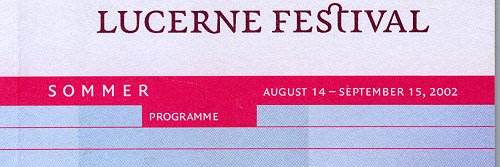
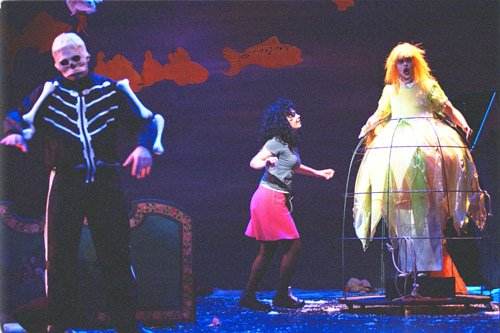
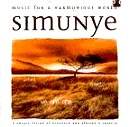
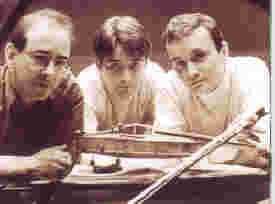

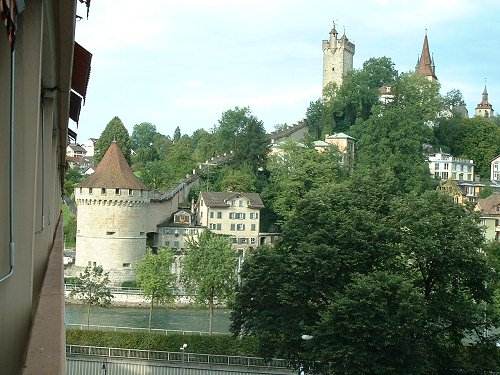



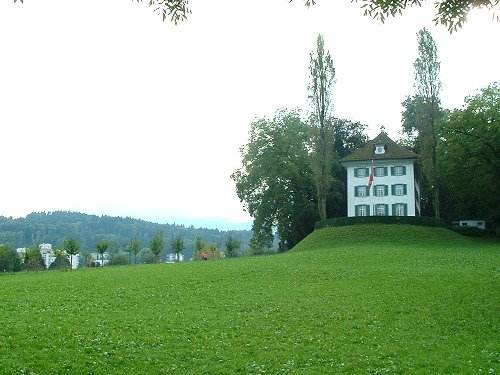
 Return to:
Return to: